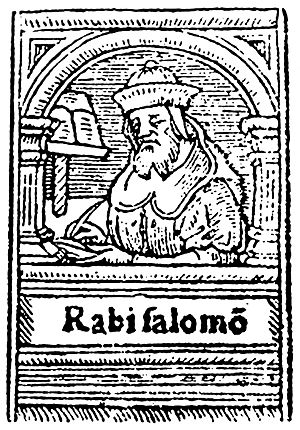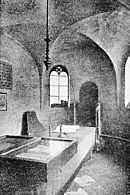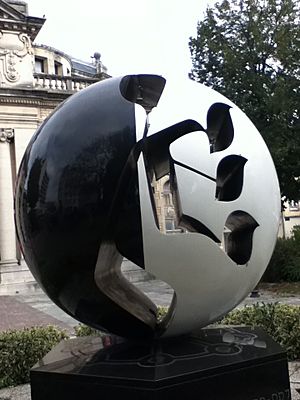Rashi facts for kids
Quick facts for kids
Rashi
רש״י |
|
|---|---|

16th-century depiction of Rashi
|
|
| Born | February 22, 1040 Troyes, County of Champagne, France
|
| Died | July 13, 1105 (aged 65) Troyes, County of Champagne, France
|
| Resting place | Troyes |
| Nationality | French |
| Occupation | Traditionally a vintner (recently questioned, see article) |
| Known for | Writing commentaries, grammarian |
| Children | 3 daughters |
Rashi (born Shlomo Yitzchaki) was a famous rabbi from medieval France. He lived from 1040 to 1105. Rashi is best known for writing detailed explanations, called commentaries. These commentaries helped people understand the Talmud and the Hebrew Bible.
His writings are praised for being clear and easy to understand. Both expert scholars and new students found them helpful. Rashi's works are still very important for studying the Torah today. Many Jewish books written since the Middle Ages talk about Rashi's ideas. His commentary on the Talmud is in almost every edition of the Talmud. His Bible commentaries, especially on the first five books (the Chumash), have led to over 300 "supercommentaries." These later works analyze Rashi's choices of words and sources.
Contents
Who Was Rashi?
Rashi's real name was Shlomo Yitzchaki. His last name, Yitzhaki, comes from his father's name, Yitzhak. The name "Rashi" is a short form, or acronym. It stands for Rabbi Shlomo Yitzhaki. Sometimes, people playfully say it means "Rabbi of Israel." This shows how important he was.
In older books, Rashi was sometimes called Jarchi or Yarhi. People thought this name might link him to a town called Lunel. However, later studies showed that "Jarchi" was a mistake. Today, everyone agrees that "Rashi" comes from his full name.
Rashi's Life Story
Birth and Early Years
Rashi was born in Troyes, France, in 1040. He was an only child. His uncle, Simeon bar Isaac, was a rabbi in Mainz. Rashi's family was well-known. Some people even say he was a descendant of King David. However, Rashi himself never claimed this.
Famous Legends About Rashi
Many stories and legends grew around Rashi because of his fame.
- One story says his parents had no children for many years. Rashi's father, Yitzhak, was a poor winemaker. He found a valuable jewel. Some non-Jewish people wanted to buy it for their idol. Yitzhak refused and threw the jewel into the sea. A voice from God or the prophet Elijah then told him he would have a special son. This son would "light up the world with his Torah knowledge."
- Another legend says that when Rashi's mother was pregnant, she was in Worms, Germany. Two carriages were coming towards her in a narrow street. She pressed against a wall, and it opened up to protect her. People say this special spot is still visible in the wall of the Worms Synagogue.
His Studies in Yeshivas

Rashi began learning the Torah from his father at age five. His father was his main teacher until he passed away. At 17, Rashi got married. Soon after, he went to study at a yeshiva (a Jewish school for religious study) in Worms, Germany. He would return home three times a year for holidays.
After his first teacher died in 1064, Rashi continued studying in Worms. He then moved to Mainz to learn from another relative, Isaac ben Judah. Isaac was a leading Jewish scholar in the region. Rashi's teachers had learned from other great scholars. They taught him the old traditions and ways of understanding the Talmud. Rashi took many notes, which he used in his famous commentaries.
Leading a Yeshiva
Rashi returned to Troyes when he was 25. He joined the city's Beth din (a rabbinical court). He also started answering questions about Halakha (Jewish law). When the head of the court died, Rashi took over. He answered hundreds of questions about Jewish law.
Around 1070, Rashi started his own yeshiva. Many students came to learn from him. People traditionally believe Rashi worked as a vintner (someone who makes wine). This is because his writings show he knew a lot about winemaking. However, some recent studies question this idea. They say the soil in Troyes wasn't good for grapes. But most scholars and Jewish tradition still say he was a vintner.
Rashi likely did not travel far from his home region. His furthest trips were to the yeshivas in Lorraine.
In 1096, the People's Crusade caused terrible events in Lorraine. Many Jews were killed, and communities were destroyed. Rashi's teacher, Isaac ben Eliezer Halevi, lost his three sons in Worms. Rashi wrote several sad poems, called Selichot, mourning these events. Seven of his Selichot are still used today in Jewish prayers.
Death and Burial Place

Rashi died on July 13, 1105, at age 65. He was buried in Troyes. For a long time, the exact location of his grave was forgotten. Years ago, a professor found an old map showing the cemetery under a public square in Troyes. After this, French Jews put up a large monument in the square. It is a black and white globe with the Hebrew letters for "Rashi" carved into it. The monument's base says: "Rabbi Shlomo Yitzchaki — Commentator and Guide."
In 2005, another plaque was added to mark the square as a burial ground. It reminds people that many important rabbis, including Rashi, are buried there.
Rashi's Daughters and Family
Rashi had no sons, only three daughters: Yocheved, Miriam, and Rachel. He made sure they received a good education. His writings and stories suggest his daughters knew a lot about the Torah and Talmud. This was unusual for women at that time. They even helped him write when he was too weak. His daughters married his students. Most Jewish rabbinical families today can trace their family tree back to Rashi's daughters.
- Rashi's oldest daughter, Yocheved, married Meir ben Samuel. Their four sons became famous scholars known as Tosafists. One of her daughters, Channah, taught women to say a blessing after lighting Shabbat candles.
- Rashi's middle daughter, Miriam, married Judah ben Nathan. Their daughter Alvina was also very learned. Her customs helped shape later Jewish law.
- Rashi's youngest daughter, Rachel, married Eliezer ben Shemiah.
Rashi's Important Works
Responsa (Answers to Questions)
About 300 of Rashi's responsa (answers to questions about Jewish law) still exist. These answers were saved and published by his students and grandchildren. Siddur Rashi, a prayer book put together by one of his students, also includes Rashi's answers about prayer. Other collections of his rulings exist too.
Rashi's writings explain and expand on the Talmud. He also wrote about prayers, grammar rules, and new religious ideas. His responsa show him as a kind, humble, and intelligent person. They also give us a look into the lives of Jews during the First Crusade. For example, he wrote about how to treat people who were forced to convert. He also wrote about the rights of women whose husbands were killed during the Crusades. Rashi always focused on carefully studying the language of the texts.
Rashi's Lasting Impact
Rashi was one of the first writers to use Old French in his works. This was the language he spoke every day. Most other French writers at the time used Latin. Because of this, Rashi's work is important not just for its religious value. It also helps us understand the language and culture of northern France in the 11th century.
Influence Beyond Judaism
Rashi's Bible commentaries were read by many different groups. From the 12th to the 17th centuries, his influence spread across Europe. He had a huge impact on Christian scholars. For example, a French monk named Nicholas de Lyra used Rashi's commentary a lot. Nicholas's work was then used by Martin Luther when he translated the Bible. Christian scholars saw Rashi's commentaries as important for understanding the Bible.
Even though Rashi influenced people outside Judaism, he remained most popular within the Jewish community.
"Rashi Script"
The special, flowing style of Hebrew letters used for Rashi's commentaries is called "Rashi script." You can see it in the Talmud and other Jewish books. However, Rashi himself did not use this script! This style of writing came from a 15th-century Spanish-Jewish handwriting. This was hundreds of years after Rashi died. Early Hebrew printers used "Rashi script" to make it easy to tell the main text apart from Rashi's commentary.
See also
 In Spanish: Rashi para niños
In Spanish: Rashi para niños


